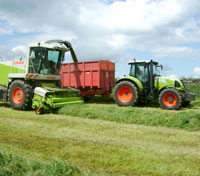Silage quality will make up for low yield

High-quality first cut grass silage will help offset reduced quantity this season, according to John Allen, technical director, Frank Wright Trouw Nutrition.
Results from 1000 first cut samples analysed by the company show crops are palatable with good energy contents.
“Average dry matter reflects the season and is nearly 1% higher than last year at 32.4%. Average D-value is also higher than in the past two years at 69.7% and this is reflected in better energy content with average ME at 11.2 MJ/kg DM,” he says.
This means that a farmer feeding 8kg DM of grass silage can expect an extra half a litre of milk from forage. “Alternatively, where stocks are limited, a farmer looking to achieve maintenance plus five litres from grass silage will be able to do so by feeding 9.38kg DM as opposed to 9.72kg last year.”
This is a saving of 1kg fresh weight a cow a day or 30t of silage for a 150-cow herd over a 180-day winter.
Results also suggest that farmers should take greater care when opening the clamp as higher ammonia nitrogen levels may indicate a greater risk of secondary fermentation.
“With forage stocks in tight supply, it will be essential to minimise waste. But the higher intake potential this year should help reduce waste as cows will be eager to eat silage.”
Dr Allen also sounds a warning about fibre levels, saying that although NDF levels and rumen stability values are higher than last year, fibre intakes and rumen health will require careful monitoring, particularly when low stocks mean silage intakes have to be restricted.
“With variable forage stocks, farmers should be thinking now about winter diet composition. The starting point must be to get silage analysed as there is huge variation between the best and worst crops and it is vital t o know what is in the clamp.”
